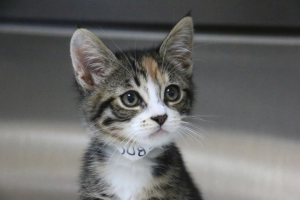The mysterious ways (to us) of cats

Zyra (A508221) is a beautiful 13-week-old kitten looking for a patient and loving adopter! Zyra can be a little shy at first. Once she’s comfortable, she’s extremely playful and loves wand toys. Zyra responds well to clicker training, she’s adorably chatty and she even got along with the small dog in her foster home! We can’t wait to see her thrive in an amazing forever home!
I’ve written before about our dear departed cat, Tubby. As I mentioned, Tubby was “special.” We adopted Tubby when he was a senior. We were his fourth home, probably because he didn’t seem to like people or animals.
But, one thing Tubby did like was headbutting. At the time, I didn’t realize the significance of his persistent headbutting — also known as head bunting.
As I continue to learn more about cats, they truly amaze me. We humans often interpret animal behavior through our own lens. But, the reality of their communication is so much more complex.
Tubby was misunderstood, which I came to appreciate as we developed mutual respect and affection for one another.
Head bunting is a way cats mark their feline friends and family. Being labelled as part of your cat’s familial group should be considered an honor. Your cat is telling others that you are their people.
Cats have scent glands throughout their body, including their chin, forehead, cheeks, at the base of their ears, around their tail, in their rear quarters — and, as we learned a few weeks ago in my column about scratching — in their paw pads.
When a cat headbutts or rubs against you, they release pheromones. Pheromones are a feline chemical communication system. These invisible secretions are not detectable by humans or dogs but are easily recognizable by other cats.
Cats also leave their scent on objects in the home. It’s a comforting behavior that reinforces that the cat is in familiar surroundings. These scents help a cat to feel safe and calm in their environment.
If it seems like your cat is repeatedly rubbing against you or items in your home, that’s perfectly normal. Each time you leave your house, you pick up different smells.
Accordingly, your cat needs to add their scent back. When it comes to objects, your cat’s scent will fade with time, necessitating another rub of the cheek to freshen up the smell.
Head bunting is not exclusively a scent marking behavior; it can be used as an attention-getter too. It’s up to you to interpret what your cat is trying to communicate through head bunting. Maybe your cat is hungry or bored and is asking for a treat or some playtime.
Some cats don’t head bunt at all, and that’s normal too. They may communicate affection in other ways.
When it came to Tubby, he loved to headbutt and rub against people’s legs, but he did not like for people to rub him back.
It’s important to try to read your cat’s signals. Like people, cats are individuals with their own preferences.
I think Tubby was conflicted. He wanted to establish relationships, but he was fearful at the same time.
I quickly learned to respect Tubby’s boundaries; all it took was one painful bite when I first tried to pet him.
But, after about a year in our home, Tubby would allow me to pick him up and place him sitting in my lap facing away from me so that I could stroke his back. Not only did he allow it, he enjoyed it…albeit for brief periods.
Please remember, Tubby was special. Who knows what he experienced in his three prior homes? Most cats are not as slow to trust as Tubby.
Kittens are another story entirely. Almost everything they do is adorable, including little love bites that may be an indicator of affection.
If you are thinking of bringing home a new kitten or cat, it’s the purr-fect time! June is Adopt a Cat Month, and Pasadena Humane is full of adorable felines.
View adoptable pets and learn more about adoption at pasadenahumane.org/adopt
Dia DuVernet is president and CEO of Pasadena Humane.
This blog post originally appeared as a column in the Pasadena Star-News on June 23, 2023.



